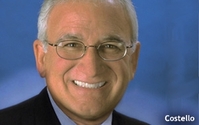Dunkin' Donuts Ties Mobile To Traditional Media
- by Mark Walsh @markfwal, May 21, 2014
 Dunkin’ Donuts is known as a mobile innovator in the retail space, through its early embrace of mobile promotions, and platforms, such as Twitter and Vine. But in a keynote talk at OMMA
Mobile, John Costello, Dunkin' Brands president, global marketing & innovation, emphasized that brands shouldn’t get caught up in the tech side.
Dunkin’ Donuts is known as a mobile innovator in the retail space, through its early embrace of mobile promotions, and platforms, such as Twitter and Vine. But in a keynote talk at OMMA
Mobile, John Costello, Dunkin' Brands president, global marketing & innovation, emphasized that brands shouldn’t get caught up in the tech side.
“While technologies change, and tactics change, the principles don’t,” he said. For Dunkin’ Donuts, that means figuring out how to use mobile to keep its 60-year-old brands (including Baskin-Robbins) relevant. In that vein, he said it’s crucial to be agile — looking honestly to assess what’s working and what’s not and be willing to reinvent the brand. For Dunkin’ Donuts, a key realization was that its business was built around coffee, rather than donuts.
“Think about the kind of transformation you have to undergo when you’re focusing on core product that’s not in your name,” he said.
Costello said its also critical for companies to clearly and concisely articulate what the brand stands for. That’s especially important in a world where mobile media is creating shorter attention spans. In Dunkin’s case, that boils down to the concept that the chain “gets you going in the morning and running all day long.”
That’s where mobile, in particular, fits in. While Dunkin' Donuts has been focused on TV advertising for most of its history, the proliferation of devices has opened up new ways to connect with consumers. “If we’re a brand on the run, what is more relevant than being able to engage in mobile?” asked Costello.
He highlighted how the company has tried to marry mobile and social marketing efforts with more traditional approaches. In that vein, Costello pointed to TV commercials spotlighting positive tweets about the brand from select customers through its #MyDunkin campaign.
Dunkin’ also ran what’s considered the first TV ad created from a Vine video, which ran as a billboard ad unit during a "Monday Night Football" game on ESPN last September. In another example of cross-media integration, the company allows people to “Like” Dunkin’ Donuts on their mobile devices via Facebook for a chance to have their picture shown as the “Dunkin’ fan of the week” on its digital billboard in Times Square.
“No matter how transformative mobile is, people are engaging in many ways, and we need to engage in all of those,” said Costello. But he also acknowledged during the Q&A session that measuring campaigns across platforms remains challenging. “The ROI techniques are much better on traditional marketing than they are on digital marketing,” he said.
Because mobile often focuses on one-to-one marketing, he suggested it should offer better returns. In that regard, he said the company has seen good results with its DD Perks loyalty program (via mobile), but didn’t provide any specifics. Sharper cross-screen measurement could help the company better allocate its marketing budget.
When it comes to working with outside partners, Costello said Dunkin’ has turned to Corefire Studios to help build its apps, Waze, for its GPS app, Epsilon and Digitas on its loyalty program and Hill Holliday on advertising.


